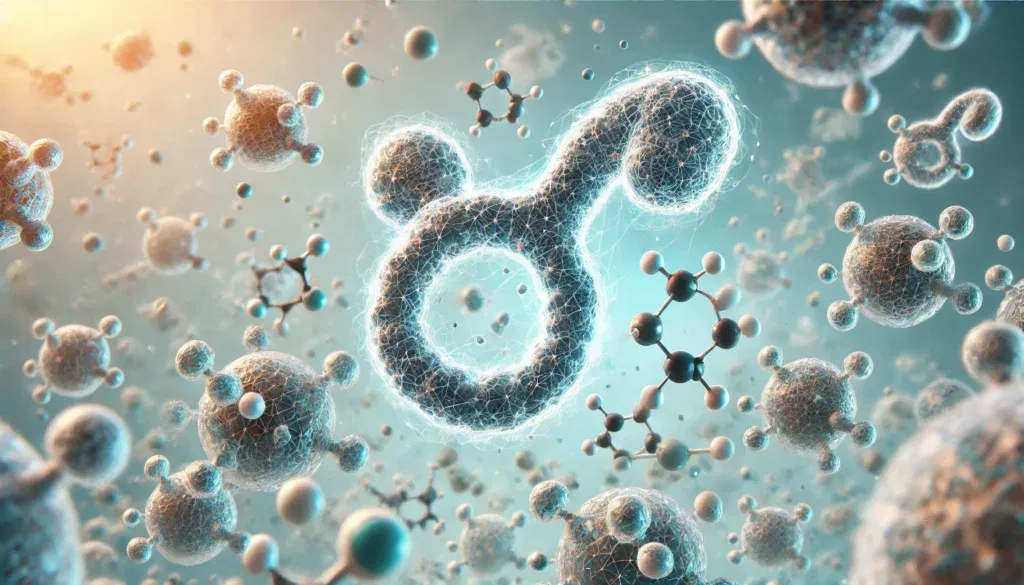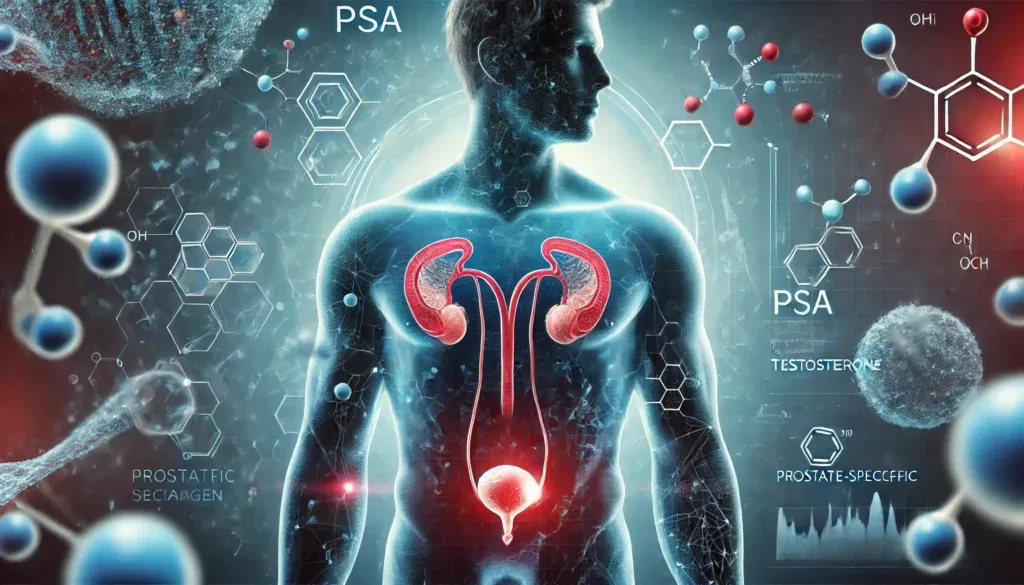Testosterone replacement therapy (TRT) has become a widely accepted treatment for men experiencing low testosterone levels. While the benefits of TRT include improved energy, muscle mass, mood, and libido, there are important health considerations that must be addressed when undergoing this therapy. One key factor that medical professionals monitor in men on TRT is prostate-specific antigen (PSA) levels. PSA levels are often used as a biomarker for prostate health, and their relationship with testosterone therapy remains a subject of ongoing research and clinical observation. Understanding how PSA and testosterone interact, the potential risks involved, and how often PSA should be checked while on TRT is crucial for men considering or currently undergoing testosterone therapy.
You may also like: How to Get Your Testosterone Levels Checked: Best At-Home and Lab Testing Options
Understanding PSA and Its Role in Prostate Health
Prostate-specific antigen (PSA) is a protein produced by the prostate gland that is found in semen and, to a lesser extent, in the blood. PSA levels are commonly used as a screening tool for prostate cancer, as elevated PSA levels can indicate the presence of prostate malignancies. However, elevated PSA levels can also be associated with benign prostatic hyperplasia (BPH), prostatitis, or other non-cancerous prostate conditions.
The normal range for PSA levels varies depending on age and individual health factors, but in general, levels under 4.0 ng/mL are considered normal. However, even within this range, a rising trend in PSA levels over time can be a cause for concern. Since PSA is influenced by multiple factors, including age, inflammation, and prostate size, it is important to interpret PSA levels in context rather than relying on a single measurement.
For men on TRT, PSA monitoring becomes an essential part of maintaining prostate health. Given that testosterone influences prostate function, there is an ongoing debate regarding whether TRT increases PSA levels and, if so, whether that increase is clinically significant. Understanding the mechanisms behind this relationship helps men and their healthcare providers make informed decisions regarding their treatment.

The Relationship Between Testosterone and PSA Levels
Testosterone plays a fundamental role in the growth and maintenance of the prostate gland. As a primary male androgen, testosterone is converted into dihydrotestosterone (DHT) by the enzyme 5-alpha reductase, and DHT is known to have a potent effect on prostate tissue. Some researchers have proposed that TRT could stimulate prostate growth, leading to increased PSA levels, while others argue that TRT primarily restores normal physiological levels of testosterone and may not necessarily elevate PSA beyond expected ranges.
Studies have shown conflicting results regarding the impact of TRT on PSA. Some studies suggest that testosterone therapy may lead to a mild increase in PSA levels, especially within the first six months of treatment, while others indicate that men with normal baseline PSA levels do not experience significant long-term elevations. It is important to differentiate between a temporary rise in PSA that may occur upon initiating TRT and a sustained increase that could indicate an underlying issue requiring further evaluation.
The question of “does testosterone cream increase PSA levels?” is also relevant for men using topical testosterone applications. Research indicates that transdermal testosterone therapy can slightly raise PSA levels, but this increase is usually within expected physiological limits. The degree of PSA elevation can vary depending on the dosage, absorption rate, and individual response to therapy. Regular PSA monitoring is recommended to track changes over time and rule out any concerning trends.
How Often Should PSA Levels Be Checked on Testosterone Therapy?
Regular PSA testing is a critical component of monitoring men on testosterone therapy. The frequency of testing depends on individual risk factors, age, and baseline PSA levels before starting TRT. Generally, men on TRT should have their PSA levels checked before initiating therapy, followed by periodic testing at three to six months, and then annually if no abnormalities are detected.
For men with a history of elevated PSA or other prostate concerns, healthcare providers may recommend more frequent testing. A sudden or rapid increase in PSA levels while on TRT may warrant further diagnostic procedures, such as a prostate MRI or biopsy, to determine if the increase is due to benign causes or a more serious underlying condition.
Additionally, PSA monitoring is crucial for older men on TRT, as aging itself is associated with increased prostate growth and higher baseline PSA levels. Healthcare providers often establish individualized screening protocols for men over 50 or those with a family history of prostate cancer. Understanding how often to check PSA on testosterone ensures early detection of potential prostate issues and helps mitigate risks associated with therapy.
Factors That Influence PSA Levels in Men on TRT
Aside from testosterone therapy itself, several factors can contribute to variations in PSA levels. It is essential to consider these variables when evaluating PSA test results:
- Age: As men age, PSA levels tend to rise gradually, even in the absence of prostate disease. This natural increase must be accounted for when interpreting PSA changes during TRT.
- Prostate Size: Men with benign prostatic hyperplasia (BPH) may naturally have higher PSA levels due to increased glandular volume. TRT may not necessarily accelerate BPH, but its presence can influence PSA readings.
- Inflammation and Infections: Prostatitis, a condition characterized by inflammation of the prostate, can temporarily elevate PSA levels. If a man on TRT experiences an unexpected PSA rise, healthcare providers may investigate for possible infections before considering treatment modifications.
- Physical Activity: Intense exercise, particularly activities such as cycling that put pressure on the prostate, can lead to transient PSA elevations. Patients should avoid vigorous exercise for at least 48 hours before a PSA test to obtain accurate results.
- Medication Use: Certain medications, including 5-alpha reductase inhibitors (like finasteride), can artificially lower PSA levels. When evaluating PSA changes on TRT, it is crucial to consider whether other medications are influencing the results.
The Importance of a Comprehensive Prostate Health Strategy
While PSA monitoring is a valuable tool in assessing prostate health, it should not be the sole determinant of risk assessment. A comprehensive approach that includes digital rectal exams (DRE), prostate imaging, and symptom evaluation provides a more accurate picture of prostate status. Men on TRT should work closely with their healthcare providers to develop a prostate health strategy that includes lifestyle modifications, dietary considerations, and appropriate screening intervals.
Maintaining a balanced diet rich in anti-inflammatory foods, such as leafy greens, tomatoes, and omega-3 fatty acids, may support prostate health. Additionally, staying physically active and maintaining a healthy weight can reduce the risk of metabolic issues that may contribute to prostate concerns. By combining TRT with proactive health monitoring, men can maximize the benefits of testosterone therapy while minimizing potential risks.

Frequently Asked Questions (FAQ) About PSA and Testosterone Therapy
1. Does testosterone cream increase PSA levels, and should I be concerned?
Testosterone cream can potentially increase PSA levels, but the extent of this effect varies among individuals. PSA, or prostate-specific antigen, is a biomarker used to monitor prostate health and screen for conditions like prostate cancer. While some studies indicate that testosterone therapy may lead to a mild increase in PSA, this does not necessarily signify an underlying issue. Regular monitoring is essential, as it helps differentiate between normal fluctuations and concerning changes. If you are undergoing testosterone replacement therapy (TRT), discuss with your healthcare provider whether additional prostate screenings are necessary.
2. What is the relationship between PSA and testosterone levels?
The connection between PSA and testosterone is complex, as testosterone influences prostate activity. In some cases, men with low testosterone levels may have lower PSA readings, which can increase after starting TRT. However, a rise in PSA does not always indicate prostate cancer—it could simply reflect increased prostate stimulation due to higher testosterone levels. Understanding the nuances of PSA and testosterone interactions is crucial in making informed health decisions. This is why periodic PSA testing is recommended for men on TRT to track any significant changes.
3. How often to check PSA on testosterone therapy?
The frequency of PSA testing while on testosterone therapy depends on various factors, including age, baseline PSA levels, and personal or family history of prostate disease. Most experts recommend checking PSA levels every three to six months for the first year of therapy. After that, annual monitoring is typically sufficient unless symptoms or abnormal PSA fluctuations occur. By tracking PSA trends over time, your doctor can assess whether testosterone therapy is affecting your prostate health. Open communication with your healthcare provider is key to determining the most appropriate testing schedule for your situation.
4. Can TRT increase the risk of prostate cancer?
One of the most debated topics regarding testosterone therapy is whether it contributes to prostate cancer risk. Current research suggests that TRT does not directly cause prostate cancer; however, it may accelerate the growth of pre-existing cancerous cells. This is why men considering testosterone therapy should have a thorough prostate evaluation before starting treatment. Regular PSA testing is a critical component of ongoing monitoring to detect any early warning signs. If PSA levels rise significantly or other concerning symptoms develop, further diagnostic tests, such as a prostate biopsy, may be warranted.
5. Does testosterone cream increase PSA levels differently than injections?
Both testosterone cream and injections can influence PSA levels, but the rate and degree of increase may vary. Creams provide a more gradual absorption, potentially leading to steadier testosterone levels, whereas injections may cause fluctuations due to peak and trough effects. Some studies indicate that individuals using testosterone injections might experience a more pronounced short-term rise in PSA compared to those using topical formulations. However, individual responses vary, and the best approach is to monitor PSA levels consistently, regardless of the testosterone delivery method. Discussing the benefits and drawbacks of each option with a healthcare provider can help determine the best choice for you.
6. What should I do if my PSA levels rise while on testosterone therapy?
If your PSA levels increase while on testosterone therapy, the first step is to assess whether the change is significant or within an expected range. A slight PSA elevation may be a normal response to TRT, but a rapid or substantial increase requires further evaluation. Your doctor may recommend additional PSA tests, a digital rectal exam (DRE), or even imaging studies to rule out any underlying prostate conditions. Lifestyle factors, such as diet, exercise, and inflammation, can also impact PSA levels. Adjusting testosterone dosage or switching administration methods might be considered if PSA changes persist.
7. How does age influence PSA and testosterone therapy?
As men age, both testosterone and PSA levels naturally fluctuate. Older men often have higher baseline PSA levels due to age-related prostate enlargement (benign prostatic hyperplasia, or BPH). Starting TRT later in life requires more careful PSA monitoring to distinguish between normal aging effects and therapy-induced changes. Additionally, older men are at a higher risk for prostate conditions, making regular screening even more essential. Understanding age-related prostate dynamics helps in making well-informed decisions about TRT and PSA monitoring frequency.
8. How often to check PSA on testosterone therapy if I have a family history of prostate cancer?
Men with a family history of prostate cancer should take extra precautions when undergoing testosterone therapy. In such cases, PSA testing may need to be done more frequently, such as every three to four months, especially during the first year of treatment. Genetic predisposition can increase the likelihood of prostate conditions, making early detection critical. A combination of PSA testing, digital rectal exams, and possibly prostate MRI screenings may be advised for higher-risk individuals. Working closely with a knowledgeable healthcare provider ensures proactive and personalized prostate health management.
9. Are there natural ways to support prostate health while on TRT?
Yes, several lifestyle and dietary approaches can help maintain prostate health while using testosterone therapy. Eating a diet rich in anti-inflammatory foods like tomatoes (high in lycopene), green tea, and cruciferous vegetables can support prostate function. Regular exercise, particularly cardiovascular and resistance training, may help optimize hormone balance and circulation. Staying hydrated and limiting excessive red meat and processed food consumption can also contribute to prostate health. Combining these strategies with regular PSA testing allows for a well-rounded approach to maintaining both testosterone and prostate health.
10. Can PSA levels decrease after stopping testosterone therapy?
In some cases, PSA levels may decline after discontinuing testosterone therapy, but this depends on several factors, including baseline PSA, prostate health, and duration of TRT use. If PSA increased solely due to testosterone stimulation, levels may gradually return to their previous state after stopping treatment. However, if an underlying prostate condition contributed to the elevation, PSA might remain unchanged or continue to rise. This is why periodic monitoring remains essential, even if testosterone therapy is discontinued. Consulting with a healthcare provider ensures that any lingering prostate health concerns are appropriately addressed.

Conclusion: Ensuring Prostate Health While on Testosterone Therapy
Testosterone replacement therapy offers significant benefits for men with low testosterone levels, but it also necessitates careful monitoring to ensure prostate health remains uncompromised. The connection between PSA and testosterone remains an area of medical scrutiny, with evidence suggesting that while TRT may cause mild PSA increases, it does not inherently lead to prostate cancer.
Understanding the answer to “does testosterone cream increase PSA levels?” and “how often to check PSA on testosterone” is essential for men undergoing TRT. Regular PSA testing, coupled with a comprehensive prostate health strategy, helps identify potential issues early and allows for appropriate medical interventions if needed. By working closely with a knowledgeable healthcare provider and staying proactive about monitoring, men can safely reap the benefits of testosterone therapy while maintaining optimal prostate health.
testosterone replacement safety, PSA test accuracy, prostate cancer risk factors, TRT side effects, testosterone therapy monitoring, men’s hormonal balance, DHT and prostate health, aging and testosterone, prostate health screening, TRT and prostate cancer concerns, men’s longevity strategies, hormone therapy for men, PSA trends in testosterone users, medical guidelines for TRT, best practices for monitoring PSA, natural ways to support prostate health, PSA fluctuations causes, low testosterone symptoms, optimal testosterone levels for men, prostate inflammation and PSA
Further Reading:
Rising PSA during Testosterone Replacement Therapy
Disclaimer: The information provided in this article is for general informational purposes only. The content does not constitute professional advice of any kind, including but not limited to medical, legal, or financial advice. HisHealthMag and its contributors make no representations or warranties regarding the accuracy, completeness, or reliability of the information presented. Always seek the advice of a qualified professional for any specific concerns or questions you may have. Neither HisHealthMag nor its authors assume any responsibility or liability for any actions taken based on the information provided in this article. The views and opinions expressed are those of the author(s) and do not necessarily reflect the official policy or position of HisHealthMag.





